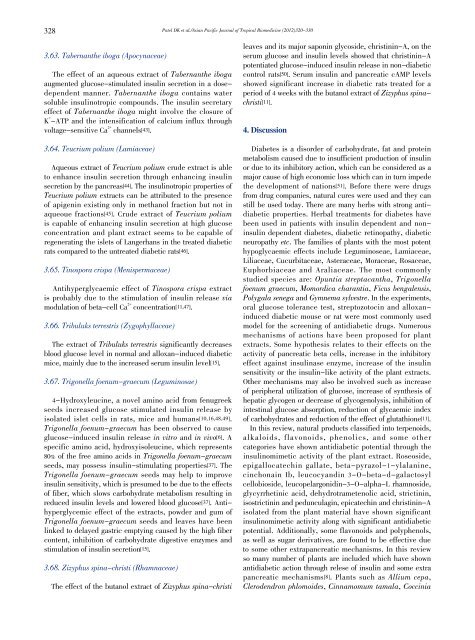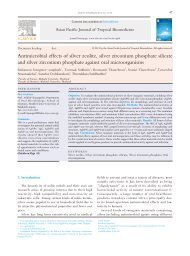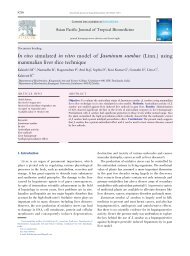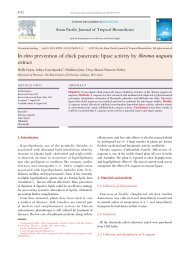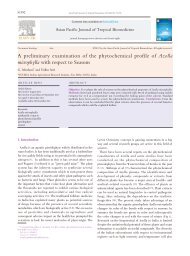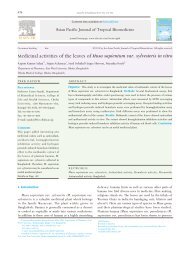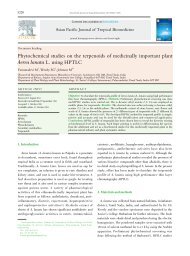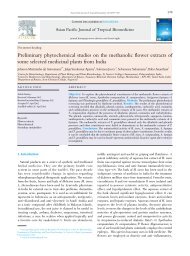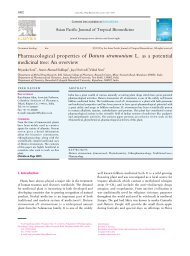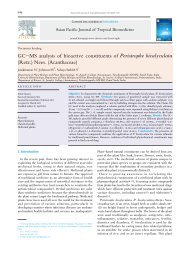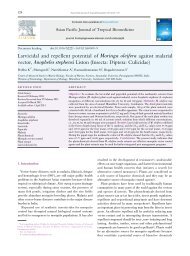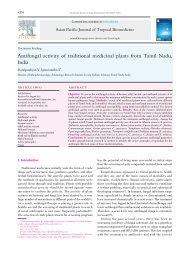An overview on antidiabetic medicinal plants having ... - Apjtb.com
An overview on antidiabetic medicinal plants having ... - Apjtb.com
An overview on antidiabetic medicinal plants having ... - Apjtb.com
Create successful ePaper yourself
Turn your PDF publications into a flip-book with our unique Google optimized e-Paper software.
328<br />
Patel DK et al./Asian Pacific Journal of Tropical Biomedicine (2012)320-330<br />
3.63. Tabernanthe iboga (Apocynaceae)<br />
The effect of an aqueous extract of Tabernanthe iboga<br />
augmented glucose-stimulated insulin secreti<strong>on</strong> in a dosedependent<br />
manner. Tabernanthe iboga c<strong>on</strong>tains water<br />
soluble insulinotropic <strong>com</strong>pounds. The insulin secretary<br />
effect of Tabernanthe iboga might involve the closure of<br />
K + -ATP and the intensificati<strong>on</strong> of calcium influx through<br />
voltage-sensitive Ca 2+ channels[43].<br />
3.64. Teucrium polium (Lamiaceae)<br />
Aqueous extract of Teucrium polium crude extract is able<br />
to enhance insulin secreti<strong>on</strong> through enhancing insulin<br />
secreti<strong>on</strong> by the pancreas[44]. The insulinotropic properties of<br />
Teucrium polium extracts can be attributed to the presence<br />
of apigenin existing <strong>on</strong>ly in methanol fracti<strong>on</strong> but not in<br />
aqueoue fracti<strong>on</strong>s[45]. Crude extract of Teucrium polium<br />
is capable of enhancing insulin secreti<strong>on</strong> at high glucose<br />
c<strong>on</strong>centrati<strong>on</strong> and plant extract seems to be capable of<br />
regenerating the islets of Langerhans in the treated diabetic<br />
rats <strong>com</strong>pared to the untreated diabetic rats[46].<br />
3.65. Tinospora crispa (Menispermaceae)<br />
<str<strong>on</strong>g>An</str<strong>on</strong>g>tihyperglycaemic effect of Tinospora crispa extract<br />
is probably due to the stimulati<strong>on</strong> of insulin release via<br />
modulati<strong>on</strong> of beta-cell Ca 2+ c<strong>on</strong>centrati<strong>on</strong>[11,47].<br />
3.66. Tribuluks terrestris (Zygophyllaceae)<br />
The extract of Tribuluks terrestris significantly decreases<br />
blood glucose level in normal and alloxan-induced diabetic<br />
mice, mainly due to the increased serum insulin level[15].<br />
3.67. Trig<strong>on</strong>ella foenum-graecum (Leguminosae)<br />
4-Hydroxyleucine, a novel amino acid from fenugreek<br />
seeds increased glucose stimulated insulin release by<br />
isolated islet cells in rats, mice and humans[10,16,48,49].<br />
Trig<strong>on</strong>ella foenum-graecum has been observed to cause<br />
glucose-induced insulin release in vitro and in vivo[6]. A<br />
specific amino acid, hydroxyisoleucine, which represents<br />
80% of the free amino acids in Trig<strong>on</strong>ella foenum-graecum<br />
seeds, may possess insulin-stimulating properties[37]. The<br />
Trig<strong>on</strong>ella foenum-graecum seeds may help to improve<br />
insulin sensitivity, which is presumed to be due to the effects<br />
of fiber, which slows carbohydrate metabolism resulting in<br />
reduced insulin levels and lowered blood glucose[37]. <str<strong>on</strong>g>An</str<strong>on</strong>g>tihyperglycemic<br />
effect of the extracts, powder and gum of<br />
Trig<strong>on</strong>ella foenum-graecum seeds and leaves have been<br />
linked to delayed gastric emptying caused by the high fiber<br />
c<strong>on</strong>tent, inhibiti<strong>on</strong> of carbohydrate digestive enzymes and<br />
stimulati<strong>on</strong> of insulin secreti<strong>on</strong>[15].<br />
3.68. Zizyphus spina-christi (Rhamnaceae)<br />
The effect of the butanol extract of Zizyphus spina-christi<br />
leaves and its major sap<strong>on</strong>in glycoside, christinin-A, <strong>on</strong> the<br />
serum glucose and insulin levels showed that christinin-A<br />
potentiated glucose-induced insulin release in n<strong>on</strong>-diabetic<br />
c<strong>on</strong>trol rats[50]. Serum insulin and pancreatic cAMP levels<br />
showed significant increase in diabetic rats treated for a<br />
period of 4 weeks with the butanol extract of Zizyphus spinachristi[11].<br />
4. Discussi<strong>on</strong><br />
Diabetes is a disorder of carbohydrate, fat and protein<br />
metabolism caused due to insufficient producti<strong>on</strong> of insulin<br />
or due to its inhibitory acti<strong>on</strong>, which can be c<strong>on</strong>sidered as a<br />
major cause of high ec<strong>on</strong>omic loss which can in turn impede<br />
the development of nati<strong>on</strong>s[51]. Before there were drugs<br />
from drug <strong>com</strong>panies, natural cures were used and they can<br />
still be used today. There are many herbs with str<strong>on</strong>g <strong>antidiabetic</strong><br />
properties. Herbal treatments for diabetes have<br />
been used in patients with insulin dependent and n<strong>on</strong>insulin<br />
dependent diabetes, diabetic retinopathy, diabetic<br />
neuropathy etc. The families of <strong>plants</strong> with the most potent<br />
hypoglycaemic effects include Leguminoseae, Lamiaceae,<br />
Liliaceae, Cucurbitaceae, Asteraceae, Moraceae, Rosaceae,<br />
Euphorbiaceae and Araliaceae. The most <strong>com</strong>m<strong>on</strong>ly<br />
studied species are: Opuntia streptacantha, Trig<strong>on</strong>ella<br />
foenum graecum, Momordica charantia, Ficus bengalensis,<br />
Polygala senega and Gymnema sylvestre. In the experiments,<br />
oral glucose tolerance test, streptozotocin and alloxaninduced<br />
diabetic mouse or rat were most <strong>com</strong>m<strong>on</strong>ly used<br />
model for the screening of <strong>antidiabetic</strong> drugs. Numerous<br />
mechanisms of acti<strong>on</strong>s have been proposed for plant<br />
extracts. Some hypothesis relates to their effects <strong>on</strong> the<br />
activity of pancreatic beta cells, increase in the inhibitory<br />
effect against insulinase enzyme, increase of the insulin<br />
sensitivity or the insulin-like activity of the plant extracts.<br />
Other mechanisms may also be involved such as increase<br />
of peripheral utilizati<strong>on</strong> of glucose, increase of synthesis of<br />
hepatic glycogen or decrease of glycogenolysis, inhibiti<strong>on</strong> of<br />
intestinal glucose absorpti<strong>on</strong>, reducti<strong>on</strong> of glycaemic index<br />
of carbohydrates and reducti<strong>on</strong> of the effect of glutathi<strong>on</strong>e[11].<br />
In this review, natural products classified into terpenoids,<br />
alkaloids, flav<strong>on</strong>oids, phenolics, and some other<br />
categories have shown <strong>antidiabetic</strong> potential through the<br />
insulinomimetic activity of the plant extract. Roseoside,<br />
epigallocatechin gallate, beta-pyrazol-1-ylalanine,<br />
cinch<strong>on</strong>ain Ib, leucocyandin 3-O-beta-d-galactosyl<br />
cellobioside, leucopelarg<strong>on</strong>idin-3-O-alpha-L rhamnoside,<br />
glycyrrhetinic acid, dehydrotrametenolic acid, strictinin,<br />
isostrictinin and pedunculagin, epicatechin and christinin-A<br />
isolated from the plant material have shown significant<br />
insulinomimetic activity al<strong>on</strong>g with significant <strong>antidiabetic</strong><br />
potential. Additi<strong>on</strong>ally, some flav<strong>on</strong>oids and polyphenols,<br />
as well as sugar derivatives, are found to be effective due<br />
to some other extrapancreatic mechanisms. In this review<br />
so many number of <strong>plants</strong> are included which have shown<br />
<strong>antidiabetic</strong> acti<strong>on</strong> through relese of insulin and some extra<br />
pancreatic mechanisms[8]. Plants such as Allium cepa,<br />
Clerodendr<strong>on</strong> phlomoides, Cinnamomum tamala, Coccinia


